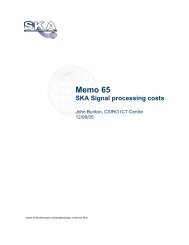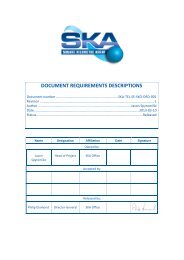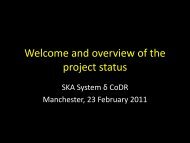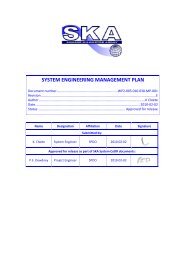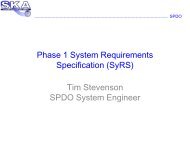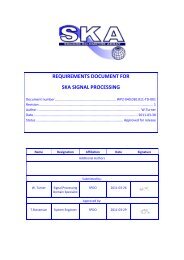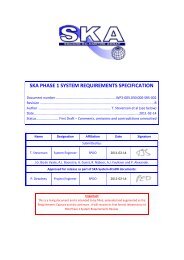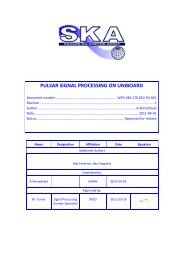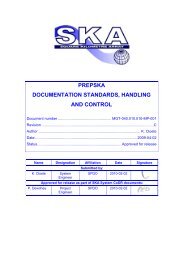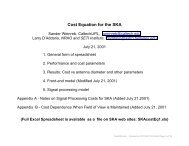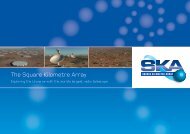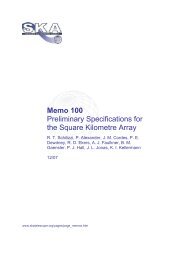COST ESTIMATION FOR THE SKA â A 'HOW TO' MANUAL
COST ESTIMATION FOR THE SKA â A 'HOW TO' MANUAL
COST ESTIMATION FOR THE SKA â A 'HOW TO' MANUAL
Create successful ePaper yourself
Turn your PDF publications into a flip-book with our unique Google optimized e-Paper software.
MGT‐040.070.000‐MP‐002Revision : BCost components in Figure 1 will be inflated according to the relevant index for <strong>SKA</strong> cost estimates inPrep<strong>SKA</strong>. At the end of Prep<strong>SKA</strong> the values assigned to these indices will be revisited and updatedusing the Eurostat data.Index Value Time period of average ReferencePPPI 1.9% 1998‐2009 Industry producer prices index ‐ annualdata ‐ (2005=100) (NACE Rev. 2)(sts_inpp_a)SPPI (excltelecommunications)2.4% 1996‐2009 Service producer prices index ‐quarterly data ‐ (2006=100) (NACERev.2) [sts_sepp_q]LCI 3.6% 1997‐2008 Labour cost index ‐ Annual data(lc_lci_r1_a)Figure 1 Indices of Inflation Values for cost estimation3. Dates – Points in time for cost estimations.Time phased costs reflect the fact that expenditure will be spread over a number of years. Forexample, expenditure to build some <strong>SKA</strong> stations might be in 2018, and then more in 2022. Thisbetter matches the possible spending profiles dictated by funding agencies.The project will define three time important dates for cost estimates• Base Year ‐ 2007• Phase 1 Procurement date – 2014• Phase 1 Software delivery date ‐ 2017• Phase 2 Procurement date ‐ 2017“The base year is used as a constant dollar reference point to track program cost growth. Expressingan estimate in base year dollars removes the effects of economic inflation and allows for comparingseparate estimates” 2 . The base year is constant across the project. The base year cost estimate canmost usefully be given as a present value, with a discount rate equal to the inflation rate, as outlinedlater in this section.To arrive at a base year estimate for <strong>SKA</strong> costing all historical or future costs will be escalated or deescalatedto the base year. For instance: A component escalated with Moore’s Law with a costestimate of €200 (2011) would be deflated to a cost estimate of €185 (2007) using the PPPI value of1.9%.4. Currency of cost estimates and currency exchangeTo avoid the need to consider currency conversion rates (which vary as a function of time), the costdata should be given in Euros. If the historical cost is not in Euros, prior to delivery it should be2 Government Accountability Office, GAO Cost Estimating and assessment guide. GAO‐09‐3SP, March 2009.http://www.gao.gov/new.items/d093sp.pdf2010‐11‐16 Page 7 of 13
MGT‐040.070.000‐MP‐002Revision : Bconverted by the user to Euros, using the exchange rate at the year of the historical cost, provided infigure 3. For traceability, it is necessary to record the price in the original currency and theconversion rate used.Currency 2001 2002 2003 2004 2005 2006 2007 2008 2009Australian Dollar 1.73 1.74 1.74 1.69 1.63 1.67 1.63 1.74 1.77Canadian Dollar 1.39 1.48 1.58 1.62 1.51 1.42 1.47 1.56 1.59Swiss Franc 1.51 1.47 1.52 1.54 1.55 1.57 1.64 1.59 1.51Chinese Yuanrenminbi 7.41 7.83 9.36 10.30 10.20 10.01 10.42 10.22 9.53Danish Krone 7.45 7.43 7.43 7.44 7.45 7.46 7.45 7.46 7.45Pound Sterling 0.62 0.63 0.69 0.68 0.68 0.68 0.68 0.80 0.89Japanese Yen108.68118.06130.97134.44136.85146.02161.25152.45130.34Korean Won1154.831175.501346.901422.621273.611198.581272.991606.091772.90Norwegian Krone 8.05 7.51 8.00 8.37 8.01 8.05 8.02 8.22 8.73New ZealandDollar 2.13 2.04 1.94 1.87 1.77 1.94 1.86 2.08 2.21Russian Ruble 26.15 29.70 34.67 35.82 35.19 34.11 35.02 36.42 44.14Swedish Krona 9.26 9.16 9.12 9.12 9.28 9.25 9.25 9.62 10.62US Dollar 0.90 0.95 1.13 1.24 1.24 1.26 1.37 1.47 1.39South AfricanRand 7.69 9.91 8.53 8.01 7.92 8.53 9.66 12.06 11.67Figure 3 Historical exchange rate figuresAll future costs should be estimated in Euros. For cost estimates based on prices today or futurepredictions the following exchange rates should be used;CurrencyExchange Rate (7 year average)Australian Dollar 1.70Canadian Dollar 1.53Swiss Franc 1.56Chinese Yuan renminbi 10.00Danish Krone 7.45Pound Sterling 0.73Japanese Yen 141.76Korean Won 1413.38Norwegian Krone 8.20New Zealand Dollar 1.95Russian Ruble 36.48Swedish Krona 9.47US Dollar 1.30South African Rand 9.48Figure 4 Exchange Rates for use in cost estimation (based on a 7 year average)These exchange rates are based on data from Eurostat 3 . At the end of Prep<strong>SKA</strong> the values assignedto these exchange rates will be revisited and updated using the Eurostat data.5. Accounting for contingency3 Euro/ECU exchange rates ‐ Annual data (ert_bil_eur_a)2010‐11‐16 Page 8 of 13
MGT‐040.070.000‐MP‐002Revision : BContingency will be calculated at a project level and should not be included in estimates of hardwareor software costs. Participating groups can suggest what level of contingency should be included fortheir particular sub‐system of interest. This suggestion should be justified, based on the perceivedlevel of risk associated with the design or cost estimate. Policy makers should take into considerationthe extent of cost coverage in estimates, the assigned BECL and the optimism bias inherent in thecosting of ambitious projects when assigning contingency to a cost estimate.6. Estimating sparesFor the purposes of consistency in cost estimation the provision for 5% per annum spares should beincluded. Where a lifetime purchase is justified this should be explained, documented and includedin the cost estimate.7. Estimating acquisition costsAn overhead will be assigned to costs to cover additional activities required to purchase thecomponents or services. This will cover the costs involved with purchase such as:• the RFT bidding process,• financial costs related to the purchase (e.g. upfront payments),• qualification costs and certification• Expert feesFor the purposes of Prep<strong>SKA</strong> this fee will be an additional 10% of the purchase price unless it is clearthat acquisition costs will be significant. In this case details of what is required in the process and anestimate of the costs should be prepared and included in the cost estimate.8. Strategy for estimating transport costsWhen assembling cost estimates the delivery terms should be identified. The minimum deliveryrequirement on the seller, based on the International Chamber of Commerce INCOterms is EXWORKS (EXW). In the majority of cases this should be specified. Other delivery agreements may beapplicable in certain cases. The relevant INCOterm should be specified, along with the costestimates, in these cases.9. Definitions of levels of expertise and rates for estimating labour costsFor the purposes of cost estimation and comparison a standard set of skill descriptors and costs aredescribed in figure 10. These figures should be used when estimating the cost of labour to theproject. The table below in no way reflects the actual salaries that will be used in the <strong>SKA</strong>. The costof labour will be dependent on the particular site selected for the <strong>SKA</strong>, the employment market atthe time of employment and the local employment laws and levies. The costs shown in figure 5 donot take into account the organisational overheads, such as offices and training etc. They arecomprised of nominal salaries for each skill level with a 25% overhead to cover employment taxes,pensions and employee medical insurance.Skill descriptor Example Indicativeeducational/trainingLabour cost €k2010‐11‐16 Page 9 of 13
Operative &ElementaryOccupationsCleaner, Gardener,Fabric TechnicianlevelBasic, Primary level,lower secondaryAdministrative Secretarial Secondary level 32Skilled trade, technical Technicians Tertiary level – 46academic oroccupationalSupervisoryOffice Manager,Technical supervisorTertiary level –academic oroccupational56ProfessionalSenior ProfessionalSenior ManagerialEngineer, Scientist,AccountantSenior Engineer,Programme manageror Senior ScientistLead Engineer, LeadScientistFigure 5 Skill levels and labour costs for cost estimation.AdvancedQualifications –academic oroccupationalAdvancedQualifications –academic oroccupationalAdvancedQualifications –academic oroccupational326378MGT‐040.070.000‐MP‐002Revision : B105Data Collection and Source VerificationAt the outset of the project and mainly due to uncertainties and unknowns, confidence in costestimates might be quite low. As the project moves forward the aim should be to refine and improveconfidence in costing estimates. Cost estimates to be included as part of the WP2 cost estimate willhave an associated Basis of Estimate Confidence Level (BECL) rating attached to it. This shouldimprove as the design process proceeds.Basis of Estimate Confidence Levels (BECL)There will be 5 levels of confidence defined as part of the basis of estimate, with the level having theleast confident estimation basis being 5 and the level with the most confidence being 1. Uponreceipt of costing estimates from contributing groups the domain specialist, in consultation with thecosting strategy manager and project engineer, will assign a BECL value based on the associatedlevels of documentation required for each level. This rating will rely heavily on the supportinginformation and documentation underpinning the particular cost estimate. Figure 2. provides detailsof the BECL ratings .Where a scaling factor has been used to extrapolate between a known price and an estimated pricethe suffix F will be added to the BECL rating as in indicator. This might happen, for instance whenusing small quantity pricing to estimate large quantity pricing or in order to estimate future pricesbased on historical price performance. When scaling has been used a description of the scaling and2010‐11‐16 Page 10 of 13
MGT‐040.070.000‐MP‐002Revision : Bjustification of its use should be included in the accompanying documentation. Examples of suchdocumentation might be technology roadmaps supplied by technology companies.The accuracy of a cost estimate for the <strong>SKA</strong> will be dependent upon both the estimate of cost peritem and the number of items required. The BECL rating will also therefore depend upon thematurity of the overall system and sub‐system design. As the project progresses design reviews willbe undertaken in order to peer review <strong>SKA</strong> plans. As these reviews are passed, so the confidence inthe design will grow and the risk associated with estimated quantities will diminish, as will the BECL.ContactsFor any questions related to the content of this document or the cost estimates in preparation for<strong>SKA</strong> design reviews please contact the relevant domain specialist, or the cost strategy manager atthe SPDO, Roshene McCool, mccool@skatelescope.org.2010‐11‐16 Page 11 of 13
Revision : BMGT‐040.070.000‐MP‐002Figure 2 Description of the Basis of Estimate RatingsBE # Description Documentary Evidence Minimum requirement forconfidence in quantities.BECL5(F)BECL4(F)BECL3(F)BECL2BECL1Lowest BE rating. Costs based on anecdotal evidence and bestguess scenarios. Undeveloped specifications and technologyunder design.Technical specifications in rough draft stage. Costs eitheranecdotal or best guess. Quantities reasonably well known. Allaspects speculative but at a mature stage of discussion withinthe group. Schedules, contracts, risk plans all in progress.Relationships with potential suppliers under development.Technical specifications under peer review. Costs obtained fromreliable sources and reiterated several times. Quantities knownto high degree. Designs finalized and agreement reached onimplementation modes. Costs and methodologies acceptedthroughout the group. Risk mitigation plan in place awaitingapproval.Technical Specifications finalized. Schedule of delivery finalized.Quantities finalized. Contractual arrangements being concluded.Variations unlikely. Integration into system known, documentedand costed. Associated labour costs known. Logistics of supplyand delivery known and costed. Costs Corroborated by at leastone other peer in the group. Risk mitigation plan approvedHighest BE rating. Meets all of the requirements for BE2.Corroborative evidence from actual costs incurred elsewhere(Precursor) .Supply contract firm. Variation possibilities verylimited or Zero. Labour rates firm for 12 months. Schedule andRisk quantified.Expert opinion,vendor target prices orhistorical prices from analogousprojects.Description of scaling laws used inestimates.Vendor written estimates,quotesrequested without competitive tenderor historical prices from analogousprojects.Description of scaling laws used inestimates.Quotes requested without competitivetender, catalog prices or historicalprices from analogous projects.Description of scaling laws used inestimates.Quotes for supply under competitivetender.The use of scaling laws to estimatecosts is not acceptable at this stage.Contract signed.The use of scaling laws to estimatecosts is not acceptable at this stage.2010‐11‐16 Page 12 of 13Concept Design Phase.System and Domain ConceptualDesign Review undertaken. (CoDR)Definition Design Phase.System and Domain RequirementsReview Undertaken. (SRR)Preliminary Design Phase.System and Domain Critical Designreview undertaken. (CDR)Detailed Design Phase.Domain Pre‐production design reviewundertaken. (PR)System Critical Design reviewundertaken. (CDR)Fabrication & assembly Phase.Contract tender quantity.
MGT‐040.070.000‐MP‐002Revision : BSubsystem DescriptionSubsystem NameDesign Review LevelDateAssigned Document Number<strong>SKA</strong> Cost Report TemplateContact Details of Responsible PartiesRole Named Contact Organisation emailDomain SpecialistSPDOSubsystem Design ContactCost Report Table of Contents(text in italics indicates requested content):1. Description of Subsystem under reviewa. Block Diagramb. Interface descriptionsc. Estimate of number of units required for <strong>SKA</strong> 1 & <strong>SKA</strong> 22. Project managementa. List of groups involved in the work and contact detailsb. Project plan with project stage highlighted3. Cost estimatea. Cost estimates itemized according to the cost component list (Fig.1.)b. Description and justification of assumptions and scaling laws used in the estimatec. Spares allocationd. 10 year cost of ownershipe. Procurement methodf. Additional significant cost items e.g. Transport4. List of supporting evidence2010‐11‐16 Page 13 of 13



